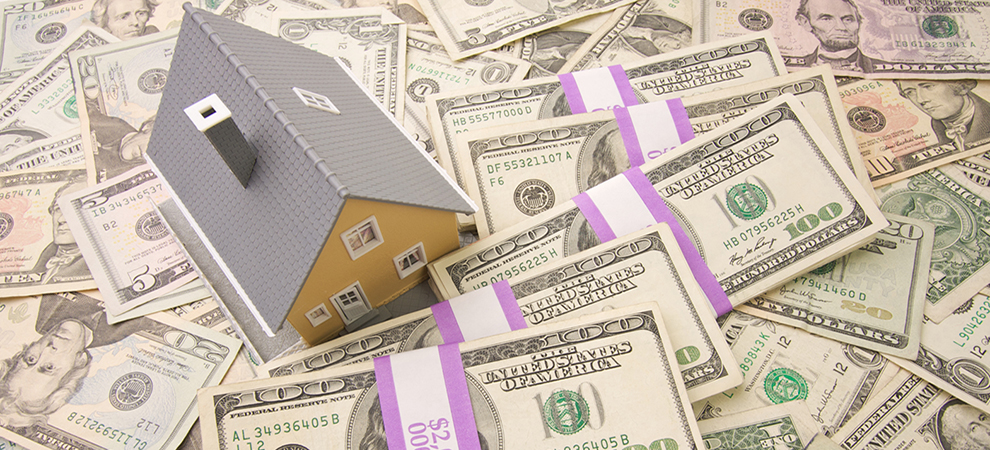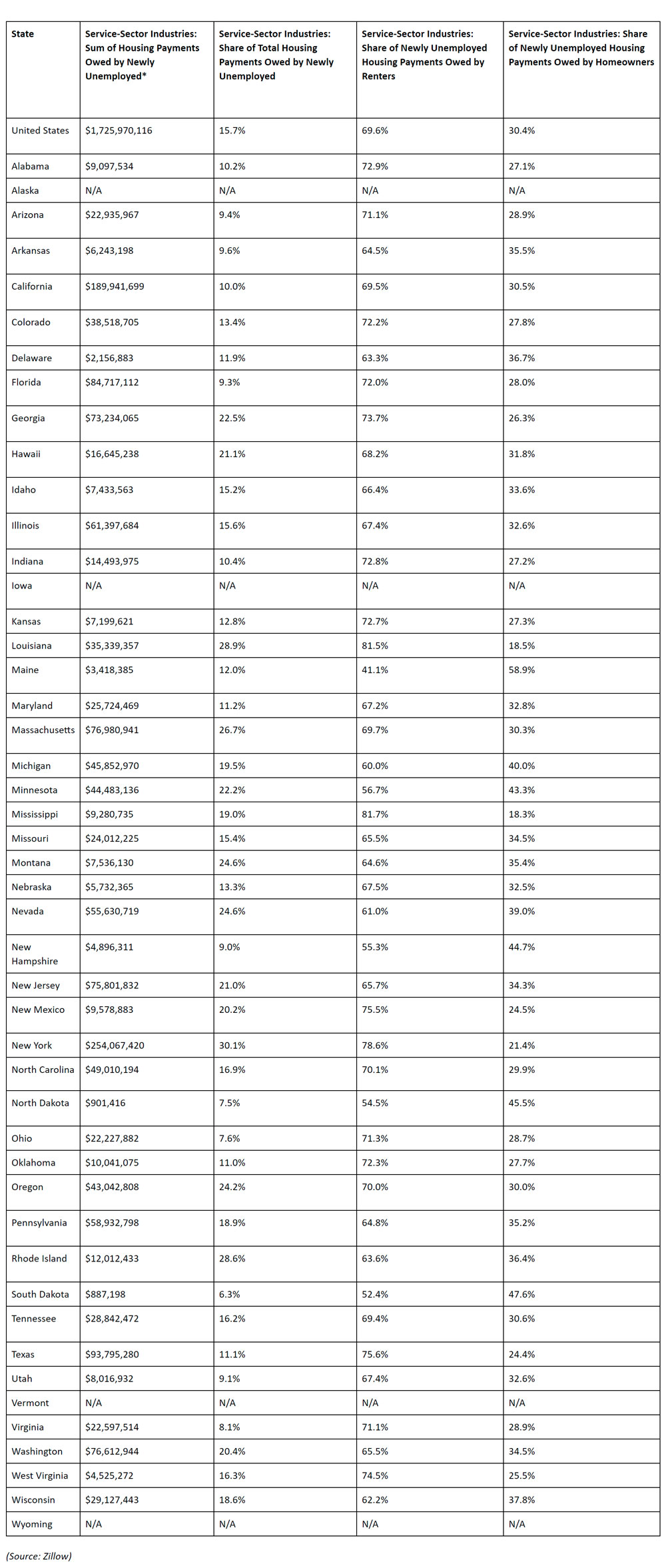The WPJ
THE WORLD PROPERTY JOURNALReal Estate Facts Not Fiction
Residential Real Estate News

$1.7 Billion a Month in Housing Payments Owed by Newly Unemployed Service Workers in U.S.
Residential News » Seattle Edition | By Michael Gerrity | June 15, 2020 9:06 AM ET
Federal and state aid is helping to plug gaps in the short term
Zillow is reporting this week that more than $1.7 billion in housing rents and mortgage payments is owed each month by U.S. service-sector workers currently receiving unemployment benefits as a result of the coronavirus pandemic -- payments that could be in jeopardy if expanded local and federal unemployment assistance fades or workers remain without incomes longer than expected.
Service-sector workers (including the food, arts, entertainment, recreation and retail industries) are perhaps feeling the greatest financial impact from COVID-19 as many shops and restaurants reduced operations or shut their doors completely. An estimated $1.7 billion in rent and mortgage payments is owed each month by service-sector workers who received unemployment benefits in April as a result of COVID-19, according to a new Zillow analysis.
About 70% of that total ($1.2 billion) is from renters, illustrating the unprecedented scale of what is at risk in the rental market. That's nearly 3% of the total monthly rent paid in the U.S., even before accounting for newly unemployed renters in all other industries -- Zillow estimates service-sector workers comprise a little more than a third of those who have lost their jobs as a result of the coronavirus pandemic. Previous Zillow research has shown renters in the food and retail industries already struggled with cost burdens before the pandemic, making it difficult for those who fall behind to catch back up.
"As we're watching resilient buyers return to the for-sale market and more renters able to pay on time in May than in April, it's important to remember that much of the confidence that led to that improvement rests on massive government aid," said Zillow Senior Principal Economist Skylar Olsen. "By supporting the more than 40 million Americans who have filed for unemployment benefits, that package is not only easing financial hardships but also safeguarding the housing market from widespread evictions and foreclosures that could have devastating effects. That safety net has an end date, so if employment does not bounce back as hoped this summer the housing recovery could be impeded, especially for renters who aren't insulated by the equity owners hold in their homes."
Safety nets including unemployment benefits, the CARES Act stimulus checks and temporary renter protections have eased tensions for many households for the short-term, at least. But with state reserves stretched, stimulus checks covering only a portion of the typical monthly rent or mortgage payment in many states, and many workers who don't qualify for benefits, a large share of housing payments could be missed eventually if government assistance expires or jobs don't return to pre-pandemic levels -- likely pushing some into housing insecurity.
Skyrocketing unemployment caused about 22% of renters to not pay any of their rent during the first week of April, up from about 18% last spring. That fell to 20% in May, a possible signal that government aid and the reopening of some businesses is helping to lessen financial stress. More assistance could be on the way in the form of the HEROES Act, but the long-term picture is unclear.
It's not only service-sector workers that are experiencing mass unemployment during the coronavirus pandemic. Some states with economies reliant on manufacturing are also feeling the impact of heavy unemployment. In Ohio, where manufacturing makes up the largest share of the state's GDP, 53% of housing payments owed by manufacturing workers are from those whose jobs have been affected by COVID-19. In Michigan, that share is 27%.
Even workers in essential industries that have been largely allowed to continue operations are not immune from unemployment. Many states halted non-emergency medical procedures, such as dental work and routine medical checkups, pushing some healthcare workers to file for unemployment benefits. In both Washington and Oregon, two states among the first to issue stay-at-home orders and limit business operations, healthcare workers receiving unemployment payments made up about 12.5% of the total housing payments owed by workers in that industry in April. That share is even higher in Georgia (19%), Rhode Island (18%) and New Hampshire (13.5%).
Sign Up Free | The WPJ Weekly Newsletter
Relevant real estate news.
Actionable market intelligence.
Right to your inbox every week.
Real Estate Listings Showcase
Related News Stories
Residential Real Estate Headlines
- More Americans Opting for Renting Over Homeownership in 2024
- BLOCKTITLE Global Property Tokenization Platform Announced
- Small Investors Quietly Reshaping the U.S. Housing Market in Late 2024
- Greater Miami Overall Residential Sales Dip 9 Percent in November
- U.S. Home Sales Enjoy Largest Annual Increase in 3 Years Post Presidential Election
- U.S. Housing Industry Reacts to the Federal Reserve's Late 2024 Rate Cut
- U.S. Home Builders Express Optimism for 2025
- Older Americans More Likely to Buy Disaster-Prone Homes
- NAR's 10 Top U.S. Housing Markets for 2025 Revealed
- U.S. Mortgage Delinquencies Continue to Rise in September
- U.S. Mortgage Rates Tick Down in Early December
- Post Trump Election, U.S. Homebuyer Sentiment Hits 3-Year High in November
- Global Listings Aims to Become the Future 'Amazon of Real Estate' Shopping Platform
- Greater Las Vegas Home Sales Jump 15 Percent in November
- Ultra Luxury Home Sales Globally Experience Slowdown in Q3
- World Property Exchange Announces Development Plan
- Hong Kong Housing Market to Reach Equilibrium in Late 2025
- Construction Job Openings in U.S. Down 40 Percent Annually in October
- U.S. Mortgage Applications Increase in Late October
- World Property Markets, World Property Media to Commence Industry Joint-Venture Funding Rounds in 2025
- New Home Sales Hit 2 Year Low in America
- U.S. Pending Home Sales Increase for Third Consecutive Month in October
- Pandemic-led Residential Rent Boom is Now Fizzling in the U.S.
- Emerging Global Real Estate Streamer WPC TV Expands Video Programming Lineup
- 1 in 5 Renters in America Entire Paycheck Used to Pay Monthly Rent in 2024
- U.S. Home Sales Jump 3.4 Percent in October
- Home Buyers Negotiation Power Grows Amid Cooling U.S. Market
- Canadian Home Sales Surge in October, Reaching a Two-Year High
- Greater Orlando Area Home Sales Continue to Slide in October
- U.S. Mortgage Credit Availability Increased in October
- U.S. Mortgage Rates Remain Stubbornly High Post Election, Rate Cuts
- Construction Input Prices Continue to Rise in October
- BETTER MLS: A New Agent and Broker Owned National Listings Platform Announced
- Home Prices Rise in 87 Percent of U.S. Metros in Q3
- Caribbean Islands Enjoying a New Era of Luxury Property Developments
- The World's First 'Global Listings Service' Announced
- Agent Commission Rates Continue to Slip Post NAR Settlement
- Market Share of First Time Home Buyers Hit Historic Low in U.S.
- Greater Palm Beach Area Residential Sales Drop 20 Percent Annually in September
- Mortgage Applications in U.S. Dip in Late October
Reader Poll
Marketplace Links
This website uses cookies to improve user experience. By using our website you consent in accordance with our Cookie Policy. Read More






